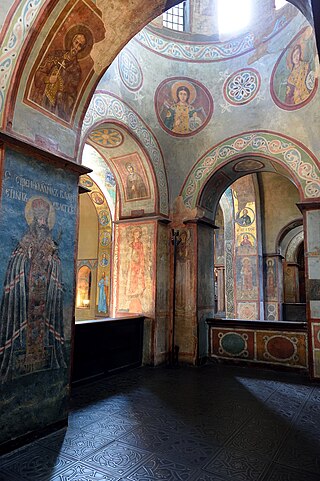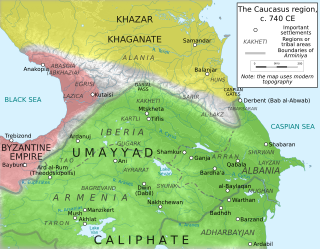
The Eastern Orthodox Church, also called the Orthodox Church, Greek Orthodox Church, or officially the Orthodox Catholic Church, is the second-largest Christian church, with approximately 220 million baptised members. It operates as a communion of autocephalous churches, each governed by its bishops via local synods. The church has no central doctrinal or governmental authority analogous to the head of the Catholic Church—the pope, although the Ecumenical Patriarch of Constantinople is recognised by them as primus inter pares, a title formerly given to the patriarch of Rome. As one of the oldest surviving religious institutions in the world, the Eastern Orthodox Church has played a prominent role in the history and culture of Western Asia, the Caucasus, and Eastern and Southeastern Europe.
The Eastern Orthodox Church, officially the Orthodox Catholic Church, is a communion composed of up to seventeen separate autocephalous (self-governing) hierarchical churches that profess Eastern Orthodoxy and recognise each other as canonical (regular) Eastern Orthodox Christian churches.
Autocephaly is the status of a hierarchical Christian church whose head bishop does not report to any higher-ranking bishop. The term is primarily used in Eastern Orthodox and Oriental Orthodox churches. The status has been compared with that of the churches (provinces) within the Anglican Communion.

An exarch was the holder of any of various historical offices, some of them being political or military and others being ecclesiastical.
The "Greek Orthodox Church" is a Christian term that can refer to any one of three classes of church, each associated in some way with Greek Christianity or the Eastern Roman Empire.

The Armenian Apostolic Church is the national church of Armenia. Part of Oriental Orthodoxy, it is one of the most ancient Christian institutions. The Kingdom of Armenia was the first state to adopt Christianity as its official religion under the rule of King Tiridates III, of the Arsacid dynasty in the early 4th century. According to tradition, the church originated in the missions of Apostles Bartholomew and Thaddeus of Edessa in the 1st century. St. Gregory the Illuminator was the first official primate of the church. It is sometimes referred to as the Armenian Apostolic Orthodox Church, Armenian Church or Armenian Gregorian Church.

The Apostolic Autocephalous Orthodox Church of Georgia, commonly known as the Georgian Orthodox Church or the Orthodox Church of Georgia, is an autocephalous Eastern Orthodox church in full communion with the other churches of Eastern Orthodoxy. It is Georgia's dominant religious institution, and a majority of Georgian people are members. The Orthodox Church of Georgia is one of the oldest churches in the world. It asserts apostolic foundation, and that its historical roots can be traced to the early and late Christianization of Iberia and Colchis by Andrew the Apostle in the 1st century AD and by Saint Nino in the 4th century AD, respectively. As in similar autocephalous Eastern Orthodox Christian churches, the church's highest governing body is the holy synod of bishops. The church is headed by the Patriarch of All Georgia, Ilia II, who was elected in 1977.

The Georgians, or Kartvelians, are a nation and indigenous Caucasian ethnic group native to present-day Georgia and surrounding areas historically associated with the Georgian kingdoms. Significant Georgian diaspora communities are also present throughout Russia, Turkey, Greece, Iran, Ukraine, the United States, and the European Union.
A catholicos is the head of certain churches in some Eastern Christian traditions. The title implies autocephaly and, in some cases, it is the title of the head of an autonomous church. The word comes from ancient Greek καθολικός, derived from καθ' ὅλου from κατά and ὅλος, meaning "concerning the whole, universal, general"; it originally designated a financial or civil office in the Roman Empire.

The Bulgarian Orthodox Church, legally the Patriarchate of Bulgaria, is an autocephalous Eastern Orthodox jurisdiction based in Bulgaria. It is the oldest Slavic Orthodox church, with some 6 million members in Bulgaria and between 1.5 and 2 million members in a number of other European countries, Asia, the Americas, Australia, and New Zealand. It was recognized as autocephalous in 1945 by the Ecumenical Patriarchate of Constantinople.
As of 2011, most Armenians in Armenia are Christians (97%) and are members of the Armenian Apostolic Church, which is one of the oldest Christian churches. It was founded in the 1st century AD, and in 301 AD became the first branch of Christianity to become a state religion.

Christianity is the predominant religion in Ukraine, with 85% of the population identifying as Christian according to a 2022 survey conducted by the Kyiv International Institute of Sociology (KIIS). Seventy-two percent of the population avowed fidelity to an Eastern Orthodox Church: 54% of Ukrainians proclaimed adherence to the autocephalous Orthodox Church of Ukraine; 14% identified as Orthodox Christian without specifying a church affiliation; 4% associated with the Moscow Patriarchate. Another 9% of Ukrainians professed devotion to the Catholic Church in Ukraine: 8% Ukrainian Greek Catholics and 1% Latin Catholics. Two percent of the population declared affiliation to a mainstream Protestant Church, and a further 2% identified with some alternative sect of Christianity.
The history of the Eastern Orthodox Church is the formation, events, and transformation of the Eastern Orthodox Church through time. According to the Eastern Orthodox tradition, the history of the Eastern Orthodox Church is traced back to Jesus Christ and the Apostles. The Apostles appointed successors, known as bishops, and they in turn appointed other bishops in a process known as Apostolic succession. Over time, five Patriarchates were established to organize the Christian world, and four of these ancient patriarchates remain Orthodox today. Orthodox Christianity reached its present form in late antiquity, when the ecumenical councils were held, doctrinal disputes were resolved, the Fathers of the Church lived and wrote, and Orthodox worship practices settled into their permanent form.

The Chosroid dynasty, also known as the Iberian Mihranids, were a dynasty of the kings and later the presiding princes of the early Georgian state of Iberia from the 4th to the 9th centuries. The family, of Iranian Mihranid origin, accepted Christianity as their official religion c. 337, and maneuvered between the Byzantine Empire and Sassanid Iran to retain a degree of independence. After the abolition of the Iberian kingship by the Sassanids c. 580, the dynasty survived in its two closely related, but sometimes competing princely branches—the elder Chosroid and the younger Guaramid—down to the early ninth century when they were succeeded by the Georgian Bagratids on the throne of Iberia.
The Guaramid dynasty or Guaramiani was the younger branch of the Chosroid royal house of Iberia. They ruled Iberia as Grand dukes (erismtavari) in the periods of 588–627, 684–748, and 779/780–786, and three of them were bestowed with the dignity of curopalates by the Byzantine imperial court.

Principality of Iberia was an early medieval aristocratic regime in a core Georgian region of Kartli, called Iberia by classical authors. It flourished in the period of interregnum between the sixth and ninth centuries, when the leading political authority was exercised by a succession of princes. The principality was established shortly after the Sassanid suppression of the local royal Chosroid dynasty, around 580; it lasted until 888, when the kingship was restored by a member of the Bagrationi dynasty. Its borders fluctuated greatly as the presiding princes of Iberia confronted the Persians, Byzantines, Khazars, Arabs, and neighboring Caucasian rulers throughout this period.

Christianity is the predominant religion in Georgia. The wide variety of peoples inhabiting Georgia has meant a correspondingly rich array of active religions in the country.
The Church of Albania or the Albanian Apostolic Church was an ancient, briefly autocephalous church established in the 5th century. In 705, It fell under the religious jurisdiction of the Armenian Apostolic Church as the Catholicosate of Aghvank centered in Caucasian Albania, a region spanning present-day northern Azerbaijan and southern Dagestan.

The Umayyad invasion of Iberia, in Georgian historiography known as an Invasion of Marwan the Deaf took place from 735 to 737, initiated by last Umayyad caliph Marwan II against the Principality of Iberia. The goals of the campaign are disputed among historians. The Georgian historiography insists its main purpose was to finally break the stiff Georgian resistance against Arab rule, however, the western historians such as Cyril Toumanoff, and Ronald Suny, view it as a general campaign directed at both the Byzantine Empire, who exerted dominion over Western Georgia, and the Khazars, whose repeated raids affected not only Iberia and the whole Caucasus, but had in 730 reached Arab lands all the way to Mosul.
This is a timeline showing the dates when countries or polities made Christianity the official state religion, generally accompanying the baptism of the governing monarch.













